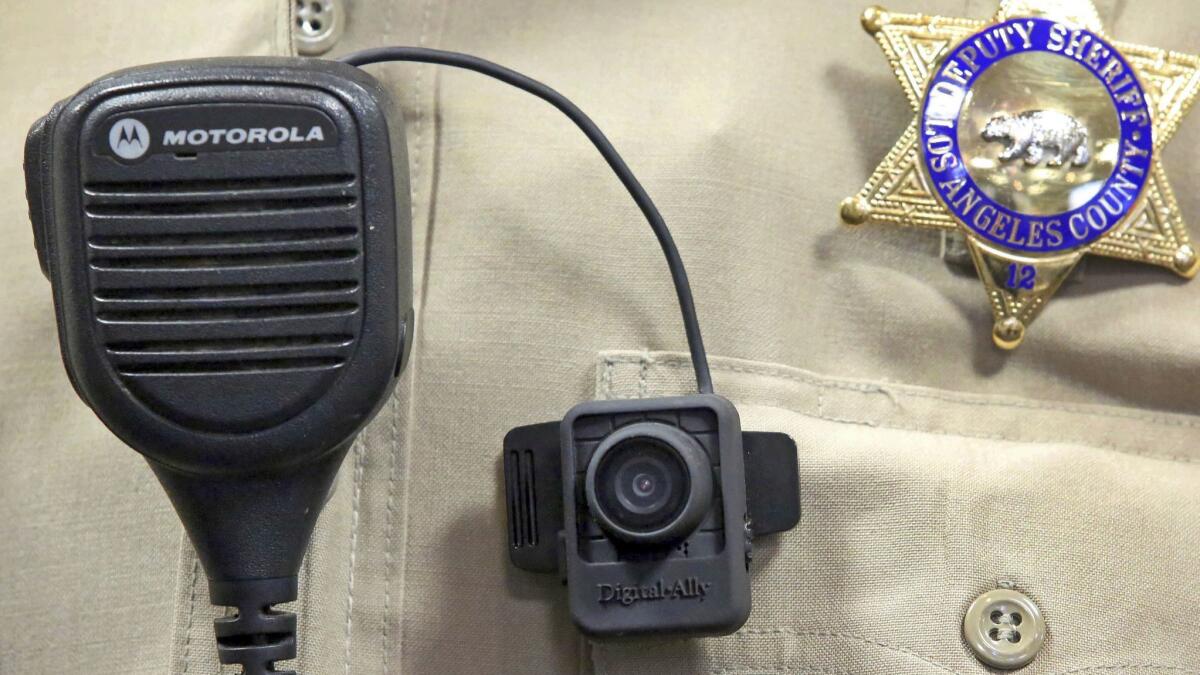Editorial: Body cameras for the L.A. County Sheriff’s Department? Get on with it already

The Los Angeles County Sheriff’s Department is one of the few large law enforcement agencies in the United States that has not yet provided body-worn cameras to all of its patrol officers. That’s despite the fact that Sheriff Jim McDonnell, his deputies and the county Board of Supervisors all say they want the cameras. The sheriff has already run a pilot program and drawn up a plan and a budget for full implementation — 5,895 cameras for patrol deputies — but the board hasn’t provided the $84 million that McDonnell says he’d need just to get started.
The sheriff hasn’t yet adopted policies for using the cameras (why bother, if he can’t buy them?), nor has he followed a county recommendation to hire a consultant to study the issue, because of more pressing concerns, such as the high number of vacancies in his ranks. Supervisors might be ready to provide funding but for the fact that some county officials question the amount that McDonnell is seeking and the long, four-year rollout period that the sheriff says he will need. The board and the sheriff appear to be at a stalemate.
Meanwhile, hundreds of deputies have bought their own cameras, and they make video available to the public — or not, more often — as they see fit, and not pursuant to any county standards.
L.A. County must do better than this.
Law enforcement agencies across the nation have recognized the value of a body-camera program that captures images of critical incidents and makes them publicly available under prescribed circumstances. Police video is often the best or even the only bit of evidence that people who’ve been wrongly accused can use to defend themselves in court, or that plaintiffs can use to support their civil claims of excessive or inappropriate police force. The mere existence of publicly accessible video tends to resolve disputes faster and with lower costs, and may protect officers from claims that are fabricated or overblown (which helps to explain why some sheriff’s deputies have bought their own).
Cameras without smart policies could too easily result in video that is used not to inform the public or to arrive at the truth, but to protect deputies.
Video may also change the behavior of officers for the better, leading them to treat people they encounter with greater dignity and respect, knowing that their interactions are being recorded.
By failing to act with necessary urgency, the county may find that others will step in. For example, when it returns from its summer recess, the Legislature will consider AB 748, a bill to set statewide standards for the release of video recordings by law enforcement agencies. The bill won’t provide cameras, but it may well set the rules for how they will be used when and if the Sheriff’s Department or any other agency finally gets around to buying them.
Body-worn camera programs are expensive. The equipment costs millions, and maintenance, software upgrades and storage for countless hours of video impose additional costs. But the sheriff estimates a much larger expense from the new personnel needed to respond to Public Records Act requests for images. The Los Angeles Police Department absorbed those costs. It’s not clear the sheriff will be able to do that; he has asked for a whopping 239 new hires. All told, the annual cost would be about $55 million.
Those figures must be weighed against the $95.1 million in civil judgments and settlements the county has paid out for excessive force involving sheriff’s deputies over the last four years. Video of those encounters probably wouldn’t have prevented the payouts, but over time, it could well affect both how deputies behave on the street and how readily plaintiffs seek huge damage payments in court.
Enter the Fray: First takes on the news of the minute from L.A. Times Opinion »
Last week, the Sheriff Civillian Oversight Commission adopted a lengthy report on body-worn cameras that recommends camera-deployment and video-release policies (30 days after a critical incident, instead of the 45 days recently enacted by the Los Angeles Police Commission). Those recommendations are important, because cameras without smart policies could too easily result in video that is used not to inform the public or to arrive at the truth, but to protect deputies. That’s the unacceptable status quo, in which deputies use their own cameras.
The commission also offered to help bridge the gap between the sheriff and the Board of Supervisors over how much the program should cost and how long it should take to roll out. If that might break the stalemate, the sheriff and the supervisors would be wise to give it a try.
Follow the Opinion section on Twitter @latimesopinion and Facebook.
More to Read
A cure for the common opinion
Get thought-provoking perspectives with our weekly newsletter.
You may occasionally receive promotional content from the Los Angeles Times.










